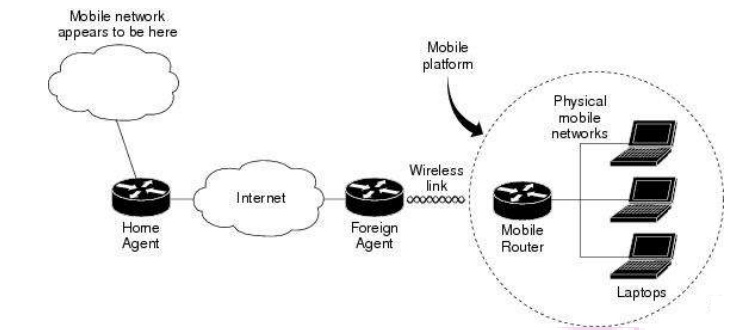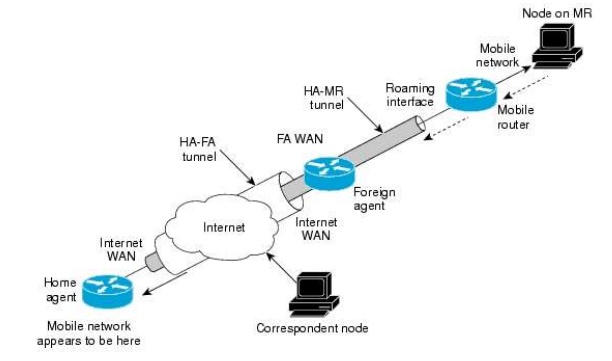Chapter: Mobile Computing : Mobile Internet Protocol and Transport Layer
Overview of Mobile IP
OVERVIEW OF MOBILE IP
Mobile IP
is an open standard, defined by the Internet Engineering Task Force (IETF) RFC
3220. By using Mobile IP, you can keep the same IP address, stay connected, and
maintain ongoing applications while roaming between IP networks. Mobile IP is
scalable for the Internet because it is based on IP—any media that can support
IP can support Mobile IP.
The Cisco
Mobile Networks feature enables a mobile access router and its subnets to be
mobile and maintain all IP connectivity, transparent to the IP hosts connecting
through this mobile access router.
Currently,
this feature is a static network implementation that supports stub routers
only. In IP networks, routing is based on stationary IP addresses. A device on
a network is reachable through normal IP routing by the IP address it is
assigned on the network. When a device roams away from its home network, it is
no longer reachable by using normal IP routing. This results in the active
sessions of the device being terminated.
Mobile IP
enables users to keep the same IP address while travelling to a different
network, ensuring that a roaming individual can continue communication without
sessions or connections being dropped. Because the mobility functions of Mobile
IP are performed at the network layer rather than the physical layer, the
mobile device can span different types of wireless and wire line networks while
maintaining connections. Remote login, remote printing, and file transfers are
examples of applications where it is desirable not to interrupt communications
while an individual roams across network boundaries.
Also,
certain network services, such as software licenses and access privileges, are
based on IP addresses. Changing these IP addresses could compromise the network
services. A device that can roam while appearing to a user to be at its home
network is called a mobile node. Examples of mobile nodes include: a personal
digital assistant, a laptop computer, or a data-ready cellular phone—that can
change its point of attachment from one network or subnet to another.
This
mobile node can travel from link to link and maintain communications using the
same IP address. There is no need for any changes to applications, because the
solution is at the network layer, which provides the transparent network
mobility. The Cisco Mobile Networks feature comprises three components—the
mobile access router (MR), home agent (HA), and foreign agent (FA). Figure shows
the three components (mobile access router, home agent, and foreign agent) and
their relationships within the mobile network.

The
mobile access router functions similarly to the mobile node with one key
difference—the mobile access router allows entire networks to roam. For
example, an airplane with a mobile access router can fly around the world while
passengers stay connected to the Internet. This communication is accomplished
by Mobile IP aware routers tunnelling packets, which are destined to hosts on
the mobile networks, to the location where the mobile access router is
visiting.
The
mobile access router then forwards the packets to the destination device. These
devices can be mobile nodes without Mobile IP client software. The mobile
access router eliminates the need for a Mobile IP client. The mobile access
router ―hides‖ the IP roaming from the local IP nodes so that the local nodes
appear to be directly attached to the home network. A home agent is a router on
the home network of the mobile access router. It provides the anchoring point
for the mobile networks.
The home
agent maintains an association between the home IP address of the mobile access
router and its care-of address, which is the current location of the mobile access
router on a foreign or visited network. The home agent is responsible for
keeping track of where the mobile access router roams and tunnelling packets to
the current location of the mobile network. The home agent also inserts the
mobile networks into its routing table.
A foreign
agent is a router on a foreign network that assists the mobile access router in
informing its home agent of its current care-of address. It functions as the
point of attachment to the mobile access router, delivering packets from the
home agent to the mobile access router. The foreign agent is a fixed router
with a direct logical connection to the mobile access router. The mobile access
router and foreign agent need not be connected directly by a wireless link. For
example, if the mobile access router is roaming, the connection between the
foreign agent and mobile access router occurs on interfaces that are not on the
same subnet. This feature does not add any new functionality to the foreign
agent component.

Related Topics